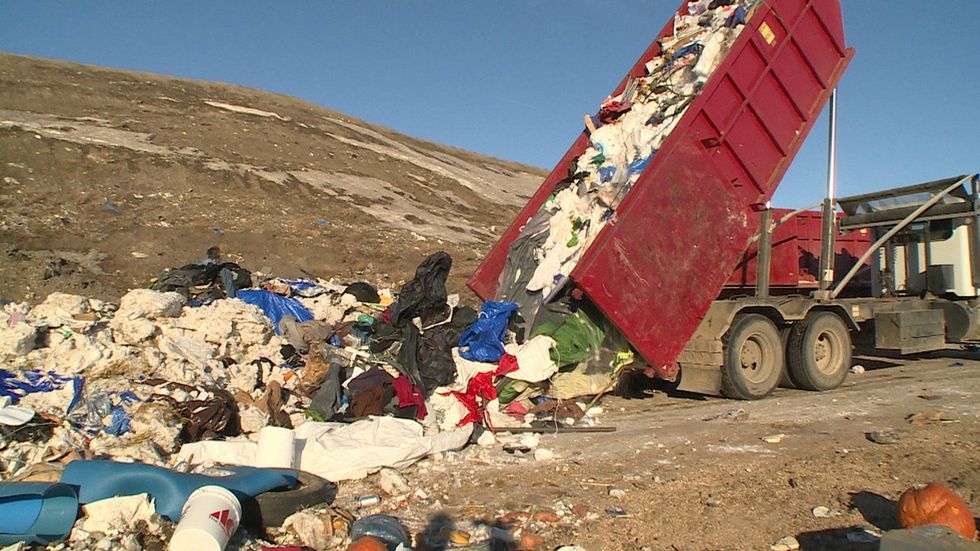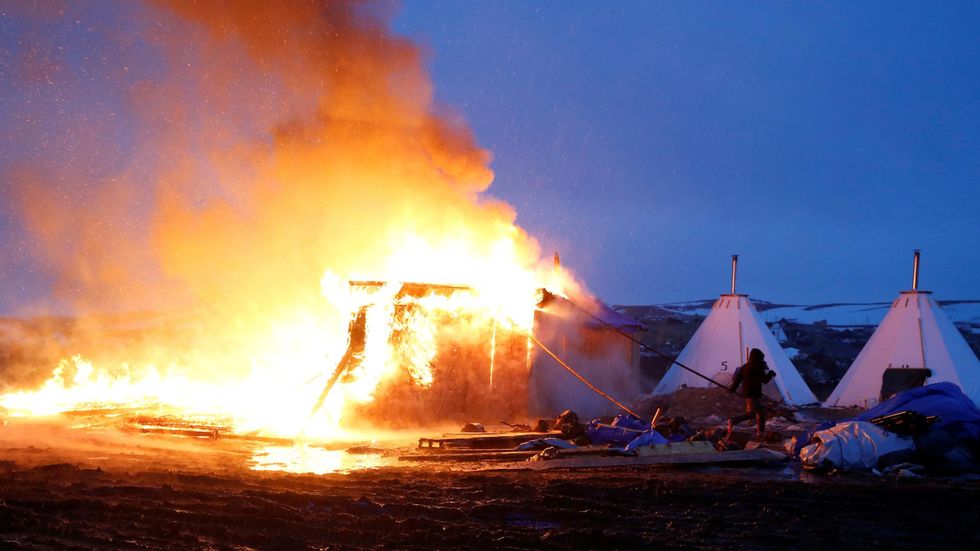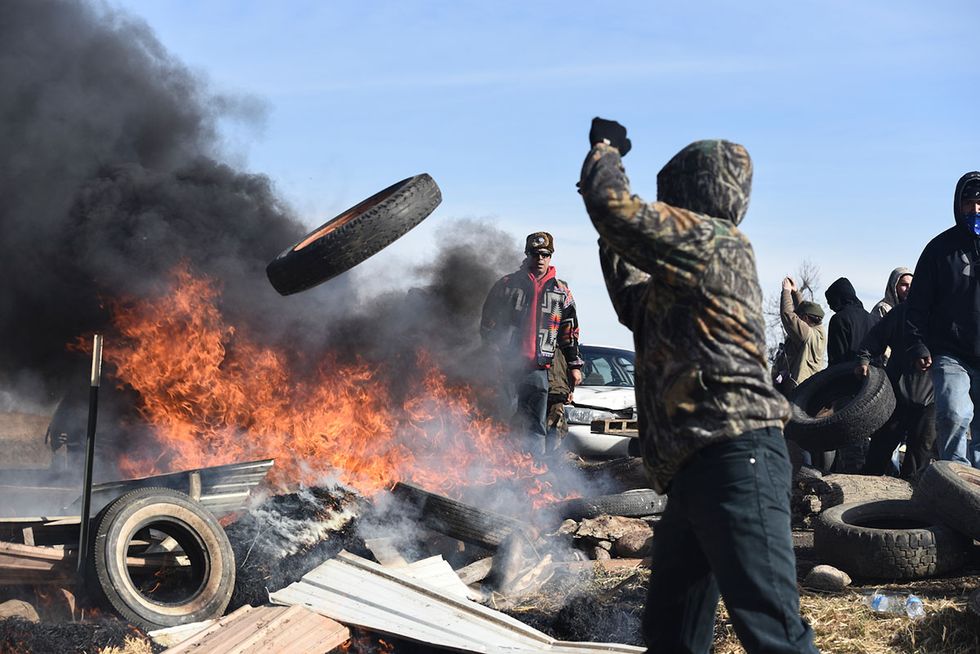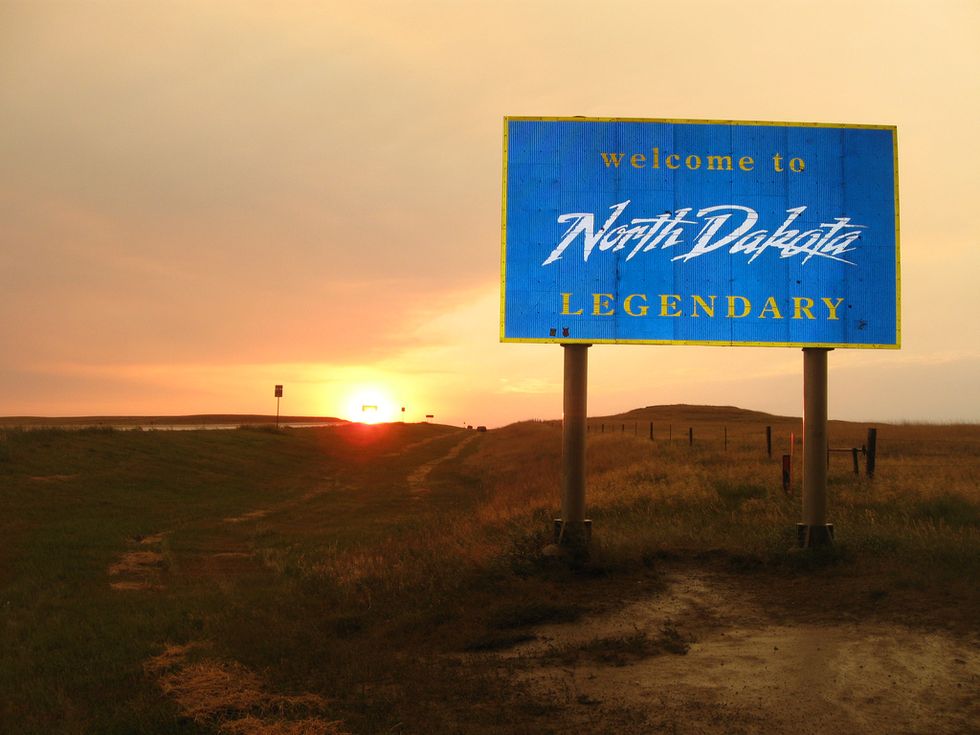The rolling plains of North Dakota are silent once again, left with only the hum of machines cleaning up rubble at the camps constructed by the Dakota Access Pipeline (DAPL) protesters. The campsites are not the only wreckage left now that most have packed up and headed home. The state is dealing with high tensions between the tribes, law enforcement, and residents.
Court systems are slammed with chart-topping caseloads as a result of violence and countless arrests accrued during the protest. Meanwhile, cleanup crews rush to get sites cleared before spring flooding, and farmers/ranchers in the area struggle to reconcile income lost at the hands of the protest. For many, the DAPL protest was a movement come, gone, and forgotten about. North Dakota will not soon forget the events of the DAPL protests as attempts to rebuild amidst the ruins are underway.
The abandoned Oceti Sakowin camp, near Cannonball, is in the final stages of being cleaned up; an estimated 840 truckloads hauled out the leftover garbage, in addition to abandoned vehicles and makeshift structures. The cleanup cost has yet to be totaled but is projected to amount to about 1.1 million dollars, to be paid by North Dakota taxpayers after the Standing Rock Tribe uses up the last of its protest donations for the efforts. Protestors were mandated to evacuate mid-February as risks of potential spring flooding mounted.
Whatever remains of trash left at the camp will likely be dumped into Lake Oahe by runoff after springtime floods, only exacerbating the irony of the situation: the protest was based upon claims that the construction of the oil pipeline would be a threat to water cleanliness and have a detrimental environmental impact. Instead, this was accomplished by the protest camp, the trashed condition it was left in, and the water pollution the lake will suffer after floodwaters recede, carrying away debris trampled into the mud.
The vandalism, destruction, trespassing, terrorizing, neglect, and abuse is having residual, resounding effects on the state. With the national attention the protest accrued, people were flooding in by the thousands. What began as peaceful, prayerful protest manifested into outright riots. The violence resulted in over 600 people being arrested, as of a January tally; 180 of these individuals had prior criminal records, and 94 percent of the total number of protesters arrested were from out of state. The court systems are trying to process an unmanageable caseload and schedule court appearances for the multitudes who were arrested and are nowhere to be found. Branches of the state will be feeling the effects of the chaos for the next few years.
Not only will the systems themselves be in repair for extended amounts of time, the individuals that comprise them, and local residents, are in the process of putting their lives back together after living for months in a state of fear. The county phone lines were inundated with hateful phone calls; recordings of over 25,000 death threats were collected during the span of the protest, one of many intimidation tactics employed by protesters.
The families of county sheriffs and private protection agencies from around the state were encouraged to relocate and change their names on social media to keep a low profile, after a list with information like addresses and phone numbers was released via social media sites by a radical protester; followers were prompted to threaten and terrorize officers and their families after this information was leaked. Families are slowly starting to regain a sense of normalcy but will carry lingering uncertainty, as some protesters have claimed to remain in the state at smaller alternate camp locations, so the danger of more turmoil looms.
Locals of the Cannonball area and residents of the state at large were affected by the menace of protest extremists, too. Farmers and ranchers near the protest sites frequently encountered trespassers on their property destroying crops or land and subsequently their livelihoods. They were not able to haul hay bales and crops because of the Highway 1806 roadblock and the liability issues they feared if something were to happen while protesters were conducting dangerous stunts near the highways, like jumping into streets to scare drivers.
There were numerous reports of stolen hay, machinery being destroyed, and livestock being slaughtered or mutilated. Fences were torn down, causing herds of cattle to scatter and go missing, likely dying under the harsh conditions of winter. Schools were closed because of the potential for violence. When they were reopened, school buses had to be escorted by law enforcement along the dicey roadways. These instances were merely the ones reported; stories of frightening run-ins with protesters have been circulated by word of mouth throughout the small community. Unfortunately, most unpublished accounts are the more serious scares, solely intended to intimidate innocent citizens.
There was a clear disregard for innocence and human rights throughout the entire protest. What began as a peaceful demonstration quickly unraveled into a malicious uproar that lost its purpose and civility. The lawsuit against the pipeline was filed on behalf of the Standing Rock Sioux Tribe by an environmental law group called EarthJustice, who also subsidized the protest.
Originally, it was supposed to be based on fears that the pipeline could contaminate a water source that provides for Native America communities, in addition to advocating for their voices to be heard. These emotionally charged issues provided the perfect opportunity for environmental interest groups to use the tribes as a platform to push their underlying, anti-fossil fuel agendas, and garner immense public interest in doing so.
The protest was not about protecting water— the pipeline does not intersect the water at any point, it will be built 95-115 feet below the bottom of the lake, and the water source providing for nearby tribal communities will be relocated to a site nearly 70 miles from the pipeline construction area. The “water is life” environmental protection message was merely a cover story. The pipeline provides a safer mode of transportation for oil, which is currently being distributed by railway all over America; it reduces emissions and prevents spills that are frequent and environmentally damaging.
North Dakota is the second leading producer of oil in the United States; having a safe method of distribution for the oil is crucial to maintaining sound infrastructure and the safety of the environment. This was an anti-fossil fuel protest, it was not about protecting the safety of people or the direct safety of the environment.
The protest also was not about advocating for Native American voices to be heard, either; the tribes were used as a platform to build an anti-fossil fuel movement upon. They disavowed and discouraged the protest and its calamitous nature soon after paid professionals were sent into the state by anti-fossil fuel groups, who began directing protest operations violently.
If anything, the Native American tribes were further abused through their exploitation by EarthJustice and other organizations. They now have to deal with the task of repairing relations with the state, law enforcement, and North Dakota residents, due to the careless, malign actions of out-of-state protesters-for-hire. The tribes certainly received attention because of the protest and had people join in their fight, regardless of the cause for battle perceived and reproduced by national media.
The nationwide media misrepresentation of the protest augmented the pandemonium. It was extremely effective in gathering support for a cause, regardless of whether that cause was portrayed factually or falsely. Integral information went unpublished when it could have quelled concerns about the pipeline and halted the impending violence.
Instead, it was contained to local news sources in order to saturate national news with information the anti-fossil fuel groups wanted to see circulated. What they did not want people to know, is that there are already 8 pipelines that run directly through the route underneath Lake Oahe, where DAPL is being constructed, the only difference being that the DAPL pipeline is being built deeper than the existing natural gas pipelines. The lines were installed in the 80’s and have yet to cause a problem or threaten the water quality of the lake.
National media outlets refuse to publish information on the continuing violence that has shifted from protest to active attacks on the pipeline itself. A few weeks ago, incidents in South Dakota and Iowa involved individuals attempting to burn holes in the pipeline at empty above ground valve shutoff sites. In light of the attacks, four states shut off pipeline valves, restricting the movement of 15 percent of America’s daily oil consumption.
These so-called environmental activists seem to want pipelines to fail in order to substantiate their claim that pipelines are hazardous; they are exploiting the fragility of the environment rather than protecting it and intentionally causing environmental destruction for the sake of supporting an argument.
Though it is inarguable that moving toward alternative energy sources and away from the massive use of fossil fuels is necessary for maintaining the health of the planet, it is undeniable that this process will be gradual and is not aided in the slightest by causing oil spills and widespread damage. National media may have failed to dispel misconceptions about the pipeline, the protest, the people involved, and the real purpose for the uproar, but this information will slowly trickle into mainstream media as the ashes settle on the campsites and the multi-faceted devastation of the DAPL protest begins to speak for itself.
If there is a silver lining buried within the controversy, it is the perseverance of the people of North Dakota, regardless of whether they stand in support of the Dakota Access Pipeline or whether they stand with Standing Rock. The DAPL protest is but a microcosm of larger issues facing society. The battle may have begun in North Dakota, but it will not end there. In the meantime, my ravaged state must face the devastation left in the wake of a storm of protest it had not seen in decades, to restore the peace and state pride it is known for.

























